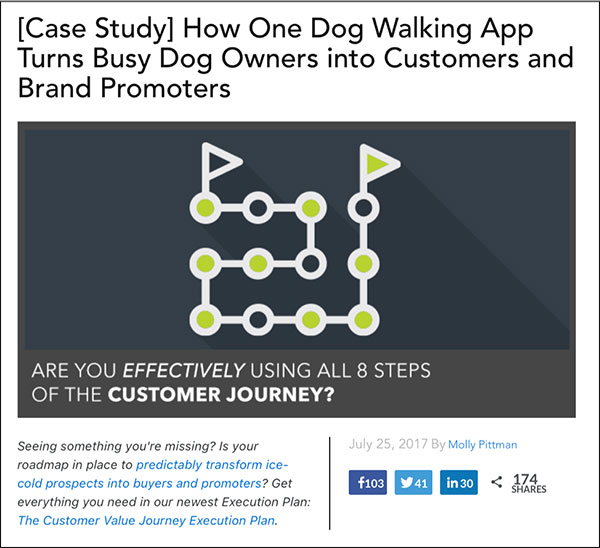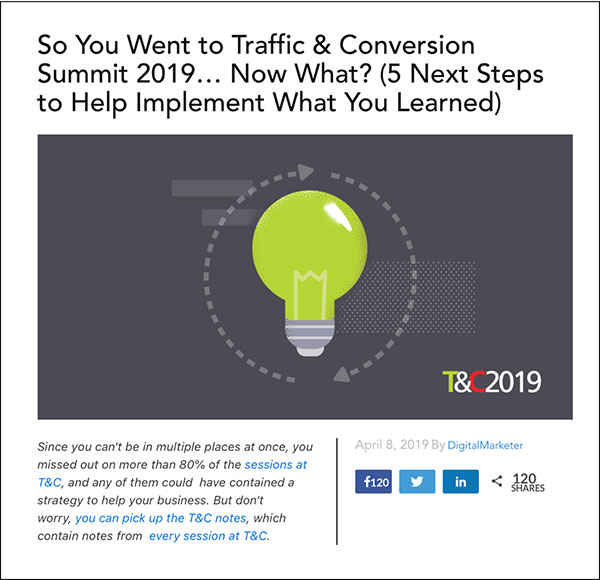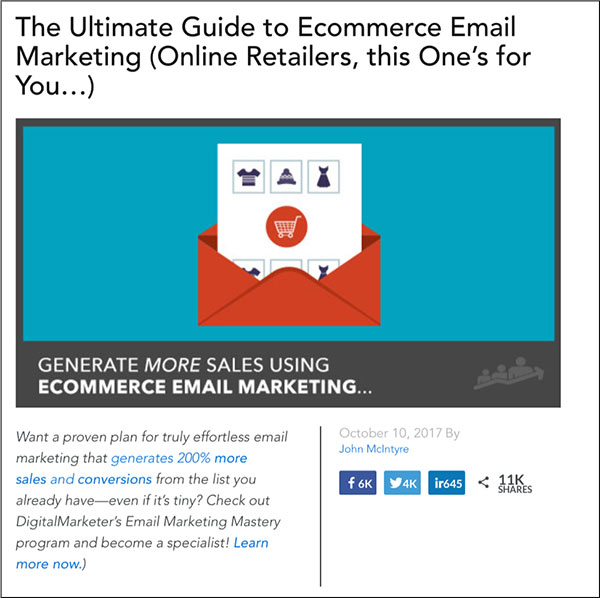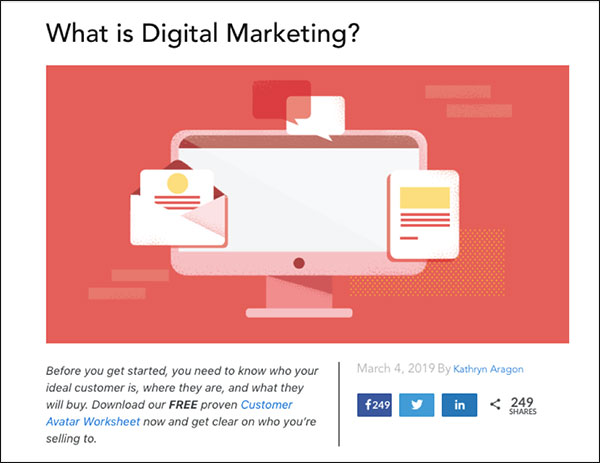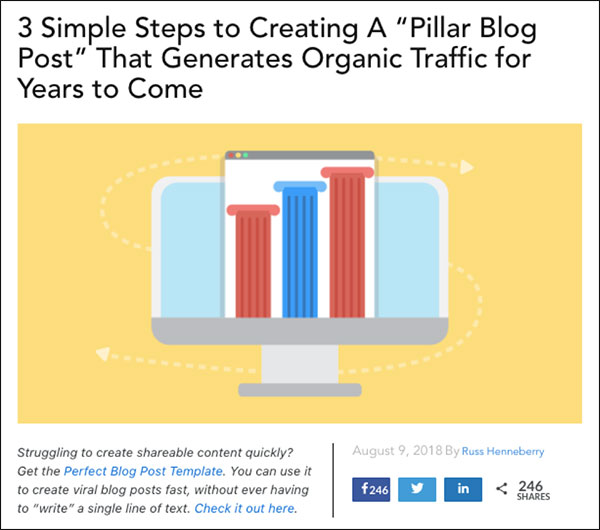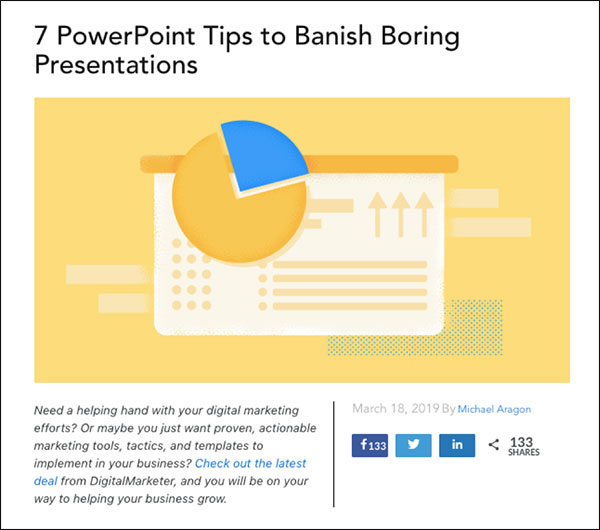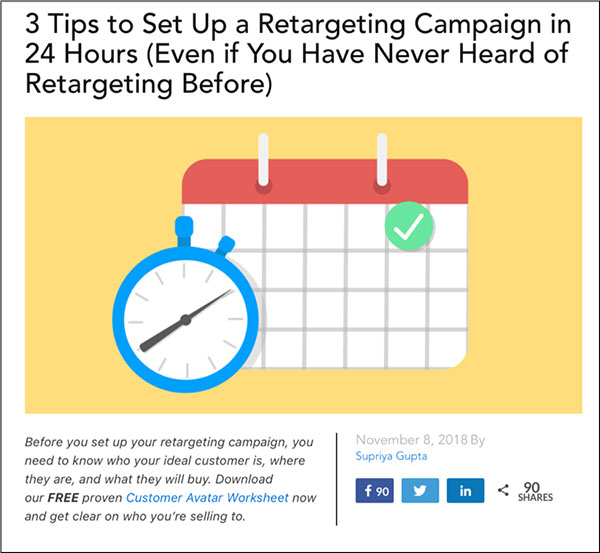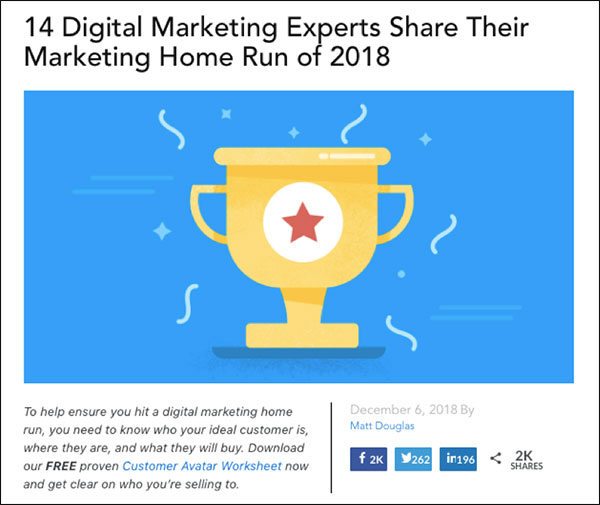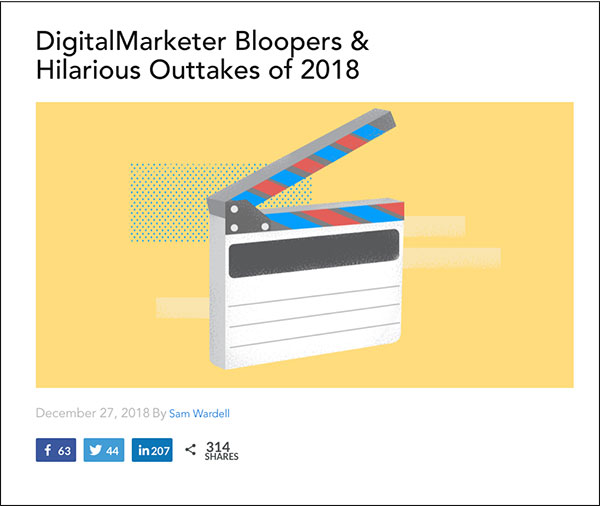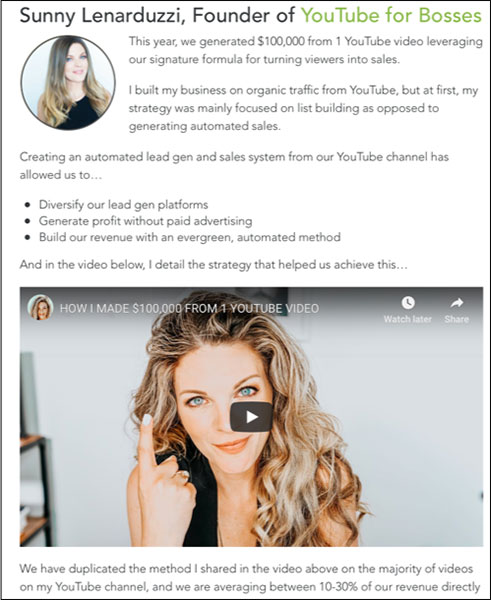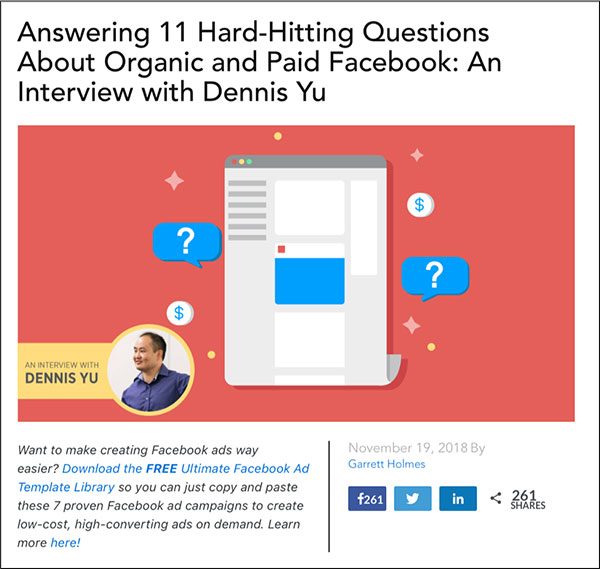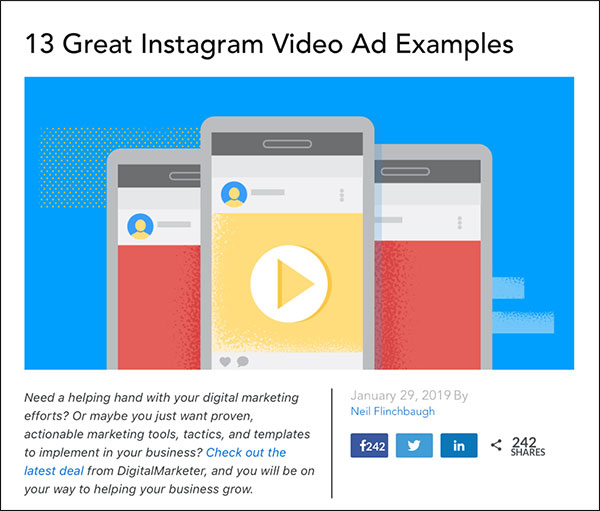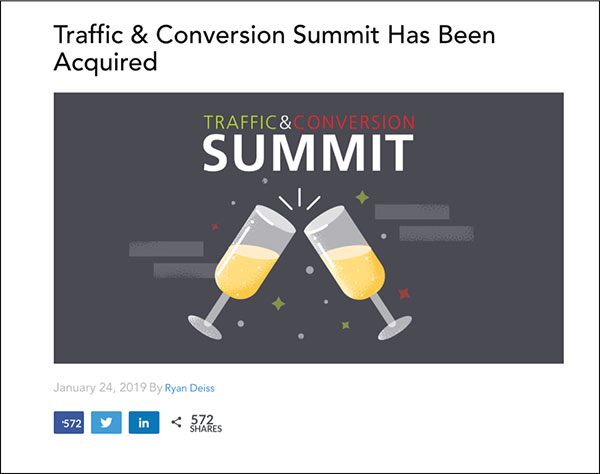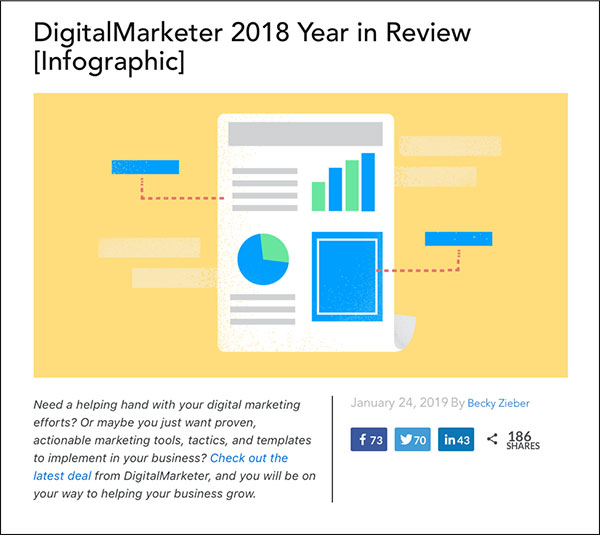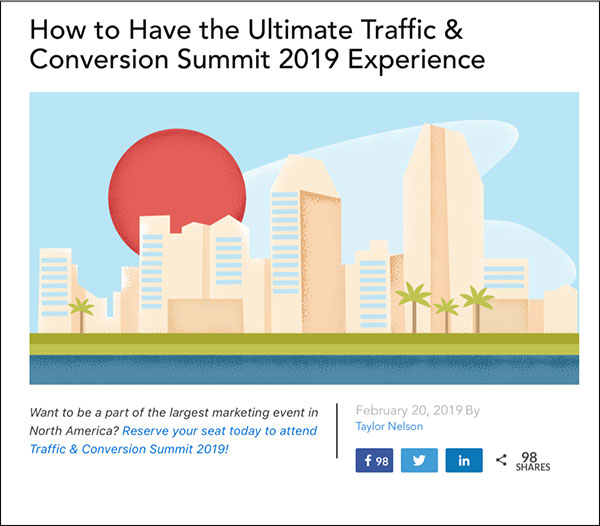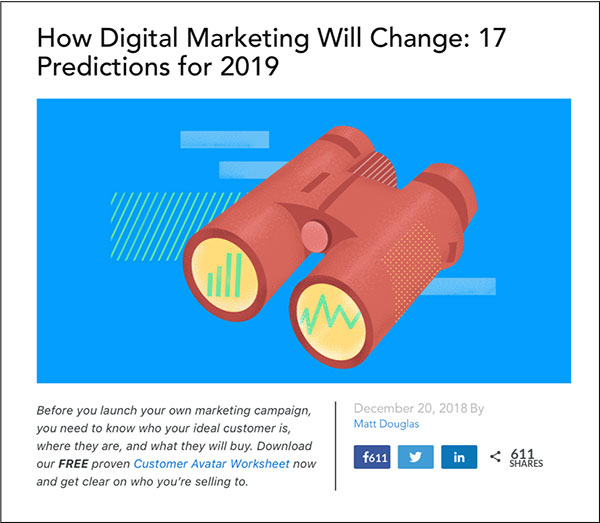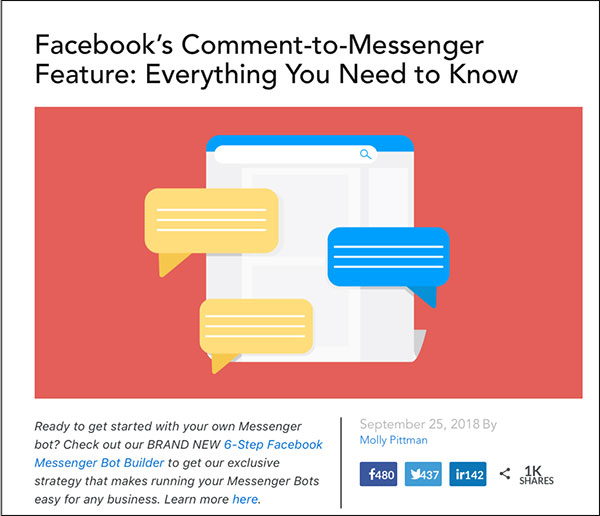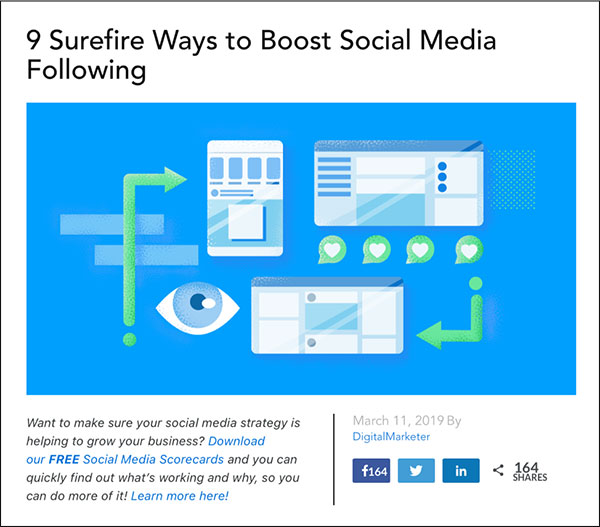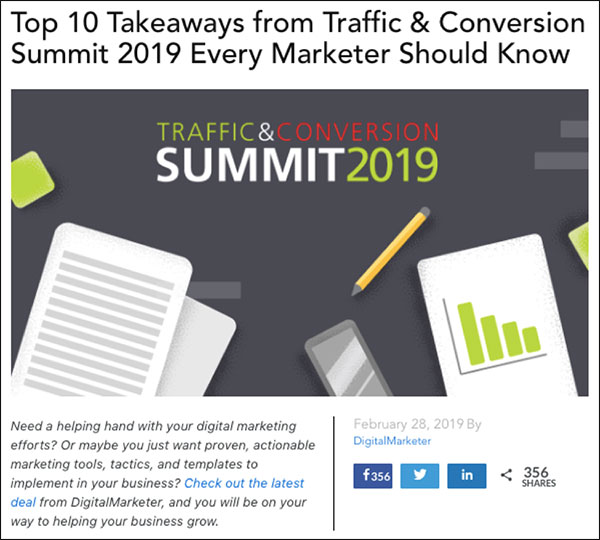If you’ve ever gotten stuck in a blog rut—you’re not alone.
Coming up with weekly blog post ideas starts to get hard, especially if you have a small team. We’ve all hit that content brick wall and thought to ourselves—“there’s just nothing left to post about.”
At DigitalMarketer, we face the same struggle. Publishing content is our thing, but that doesn’t mean every now and then we don’t sit down and think, now what?
So to make sure this happens as infrequently as possible, we’ve created the The Ultimate List of Blog Post Ideas. You can check out the infographic linked below, or read on to get more explanation and curated examples of many of these post ideas.
We’ve grouped the ideas based on 8 goals for a blog post. This way you are writing posts that best fit your needs, rather than just churning out posts.
Useful Posts
Generous Posts
Entertaining Posts
Timely Posts
Human Posts
Promotional Posts
Controversial Posts
Engaging Posts
Here is the ultimate list of blog post ideas so you never face blog writers block again.
Download the full infographic HERE!
Useful Posts
List Post
List posts are everywhere, and for good reason… they flat out work. Create a list of books, tools, resources, or any other thing that your market will find useful.
The DigitalMarketer blog gets a ton of traffic when we post list style articles about book recommendations. So, guess what we keep posting?
You guessed it. Here’s one of our book recommendation articles.
How-To Post
The How-To Post is another staple blog post idea. This post describes how to execute a process and uses images, video, or audio to enrich the post and make it as easy as possible for your visitor to take action.
An example of a How-To Post is our blog post, “How to Design Facebook Ad Images Like a Pro (…When You’re Really an Amateur).”
Case Study Post
Using “case study” in your headline makes your article sound like it has more value than a regular blog post. Case studies carry weight; you know you’ll learn something from a case study post because they always open the hood on something we’re curious to know more about. The firsthand experience makes these posts extra juicy.
Case study posts outline and unpack the details of a project, event, or process and show you how it turned out.
Molly Pittman wrote a case study post on the dog walking app Wag for the DigitalMarketer blog:
Problem/Solution Post
This type of post has an easy format:
Define a problem
Present the solution
This post can cross over into the territory of other blog post types such as the FAQ Post, How-To Post, or Checklist Post.
You’ll start to notice that a lot of the DigitalMarketer blogs are problem/solution posts because that’s our thing. Our goal is to help marketers solve their problems, so naturally we write a lot of solution-based posts.
If you attended the 2019 Traffic & Conversion Summit, you’ll know that one of the biggest problems our attendees have when they leave is that their heads are full of TOO much information. To help combat this symptom of T&C, we wrote a blog post that showed attendees what to do to organize themselves and start executing on all of the hot tips they got at the summit.
FAQ Post
If you get repeat questions from customers or prospects, there is a good chance they are typing these same questions into Google and other search engines. You can also use online tools to figure out what questions your customers have.
For example, we’re big fans of using Quora to figure out what content to create. On Quora, people ask questions and anybody can answer them. You can search for “digital marketing” (or any relevant keyword for your business) and see what the most commonly asked questions are around it. Then you just create content around these topics.
One question we get day after day is how do I write good headlines for my blog posts? We answered that question in this blog post.
Research Post
Conducting your own primary research around a topic in your niche is one of the best ways to build blog content that gets attention.
Not only will this frame you as the authority, but this post can also serve as a valuable resource and be linked to by other blogs referencing your research. And we all know what happens when another website backlinks yours—your SEO ranking goes up.
Checklist Post
If the content you are delivering can be broken into a “checklist” it will often perform better. People like the checklist format because it’s easy to digest and act on when the content is itemized in this way.
For example, we wrote this blog post, “[Checklist] 5 Copywriting Elements to Test on Your Landing Page.”
The Ultimate Guide Post
The ultimate guide post is just what it sounds like—a detailed, comprehensive post on a topic in your niche. The most important part of this post is that you’re staying true to your word. If you promise the ultimate guide, you better deliver.
For example, our blog post, “The Ultimate Guide to Ecommerce Email Marketing (Online Retailers, this One’s for You…)” is 16,000 words long and uses over 70 pictures to make the content as clear as possible.
Definition Post
In niches where there might be complicated ideas or confusing terms, the definition post is an absolute must. Consider creating a series of posts that define aspects of your niche. The DigitalMarketer blog is full of these types of posts, even including one titled “What Is Digital Marketing?” Don’t forget—just because you know a lot about your industry doesn’t mean your customer does.
What basic knowledge does your customer need to know that you’re overlooking?
For example, we published the post, “What is Email Marketing? A Quick Guide to Getting it Right.”
Series Post
Look for opportunities to break a topic into a series that can be released each day over the course of a week or month. Link these articles together as you publish them.
For example, our “What Is Digital Marketing” blog post is the first in a series of definition posts, the second being our “What is Email Marketing?” post, and so on.
Stats Post
This post (like the Research Post) works best when you can use statistics that you have produced. That said, consider curating and pulling together stats from multiple locations to create a good statistics post. These posts are also great reference points for other blogs to use and can help your SEO.
(NOTE: Need a helping hand with your digital marketing efforts? Or maybe you just want proven, actionable marketing tools, tactics, and templates to implement in your business? Check out the latest deal from DigitalMarketer, and you will be on your way to helping your business grow.)
Pillar Post
A Pillar Post uses evergreen content that is core to your company to create a content pillar that you can link back to often. This helps create a consistent source of traffic for you and your business.
This can be a really helpful if you are just starting out with your blog and need a foundation of good content. And remember, you can always have more than 1 pillar post.
Learn more about creating a Pillar Post here! This post—yes, about pillar posts—serves as a great pillar post for DM.
Video Review Post
With a Video Review Post, just review a video that’s related to your audience. This can be done as either a review of the whole video, or you can take screenshots, add explanations, and embed the video into your post.
Tips Post
Here is a super easy way to create a blog post. Just compile a list of tips for your audience. These can be tips on how to do something better, tips for getting a good deal on something, or any other relevant subject for your audience.
We created a post for tips on how to make PowerPoint less boring, that way our audience could create better presentations.
SAQ Post
The Should Ask Question Post is a variation of the FAQ post. This is a question that customers or prospects don’t ask—but they should.
What are your customers always overlooking that you can shine a light on?
For example, marketers overlooking retargeting campaigns are missing out on a huge conversion opportunity. We shined the light on retargeting and gave 3 easy steps to set up a retargeting campaign.
Tools Post
Like the Tips Post, this is an easy way to stay useful with your audience. Just post a list of tools that you think your audience will find helpful. You can rate them, review them, or just make it a simple list.
For example, we created a list of our favorite keyword research tools.
Human Posts
Inspirational Post
Some of the most effective content on the web is neither informational or entertaining—it simply inspires. This kind of post can work well as a Story Post, Profile Post, or Quote Post among others.
At the 2019 Traffic & Conversion Summit, Ryan Deiss dropped major knowledge on the crowd during his Opening Keynote Speech. He talked about the current state of marketing and how everything is poop. Seriously, that is exactly what he said (there were also many poop emojis involved).
In true Ryan Deiss fashion, he made us cry and then he made us laugh. By the end of his speech, everyone at T&C was hungry to be one of the marketers who makes it through the next disruption in the industry.
Here’s the blog article we wrote off of his keynote.
Holiday Post
Some blogs go dormant on popular holidays while others use the opportunity to deliver well-wishes to their audience and display their humanity. For example, you can write articles about holidays and how they affect your industry.
Guard-Down Post
When a content creator lets their guard down by delivering a deeply personal experience that the audience to relate to, the audience is going to feel way more connected to you and your company. So go ahead and get vulnerable.
Behind the Scenes Post
If you have a loyal following, they will want to see what goes on behind the scenes of the content that you can create. Transparency creates a stronger connection between you and your customer.
If you’ve noticed, DigitalMarketer is really transparent. We’ll talk about our views, our numbers, and our strategy. During one of Roland Frasier’s presentations at T&C, he explained exactly how we make money off of our events and how we’re going to keep making more money despite having sold T&C this year.
Behind the scenes post connect us to you. It shows you guys that we’re not bigger or better, we’re playing the same game and we want to be your teammate, not your competitor.
Off-Topic Post
This can be risky, but if you have a loyal following that has become accustomed to you covering a specific set of topics—this kind of post can shock them and receive a great response.
Rant Post
The rant post shows your human side by revealing your passion and anger about a topic that is relevant to your audience. This type of post is for a specific brand whose customers aren’t going to be appalled by their anger. We don’t have any DigitalMarketer examples to show you for this type of post because that’s not our brand.
For some brands, this type of post is going to go viral in your community.
Home Runs Post
It’s human to celebrate the wins (and it’s also one of our core values!) and talk about when things go right. Share your company’s home runs in a blog post so that your audience can see what you are doing that is working (and hopefully use that knowledge themselves).
This post works as well as a yearly reflection, or as an event wrap-up. We at DM do a yearly home run post that includes home runs from our partners as well as our internal employees.
Bloopers/Mess-Ups Post
Just like it’s human to celebrate the wins, it is human to mess up and learn from it. Showing your customers that you mess up will help them see you as human, and they will feel more connected to you.
This can be a reflection post about the mistakes your company has made, or it can be a video blooper reel, like our yearly blooper reel on the DM blog.
Generous Posts
Profile Post
The Profile Posts profiles an influential person in your niche. The most important part of this post is not to publish it and forget it. Don’t expect the person to telepathically know that you just wrote a killer blog post highlighting them.
Tweet them, tag them on your Instagram story promoting the article, tag them on Facebook, email them, and if you can, call them. What you’re aiming for is that they see your profile and share it with their audience (so you both get more traffic).
Crowdsourced Post
Crowdsourcing is a great way to get as many experts and influencers as possible in one place at a time. Have each influencer talk about a single topic and then put it together in a blog post.
For example, we had 14 digital marketing experts tell us about their best campaigns and marketing strategies in 2018 (this is also an example of a Home Run Post). Then, we threw it in a blog post and published it so everyone could get the scoop.
Interview Post
It’s surprising how willing even the most influential people are to give you an interview—even if you have a small audience on your blog. Remember that an easy way for an influencer to give you an interview is through audio—all they have to do is call you and start talking.
For even more content, you can record this interview through video and post it to YouTube and Facebook, and then transcribe it into a blog post. If you’re feeling really spicy, you can splice up some key talking points (30–60 second videos) and share them on your socials to promote the blog post/full video.
We did this for an interview with Dennis Yu, to great success.
Link Roundup Post
This type of post can work well as a series that publishes once a month or once a week. Curate, link to and provide a description of multiple pieces of content that your audience will find valuable.
Find content that is relevant to your customer and put it in one place for them. You don’t have to necessarily provide the content, you just need to create the place where it’s all conveniently organized.
Quote Post
People love quotes from influential people. They. Love. Them.
Pull together quotes from multiple influencers across a specific topic to create a Quote Post.
Again, if applicable—be sure to notify the people that you’ve quoted to see if you can get a retweet mention, or share.
Best of the Web Post
The Best of the Web Post often includes content, tools, and other resources that you have curated, linked to, and described. For example, you could have a Friday blog post that rounds up the 5 best most important things that happened in your niche that week.
Pick of the Week Post
This is a popular type of series post and is usually a relatively short blog post that describes a single piece of content, tool, or other resource that you have curated, linked to and described.
People to Follow Post
Curate a list of influential people, describe them, and provide links for your audience to connect with them through their website, social media channels, events, books, etc.
DigitalMarketer, for example, wrote a blog post on, “7 Women in Marketing to Watch Out For.”
We highlighted what their specialty is, where to find them, the things they’ve achieved that make us say, “woaaaahhhh” and what they’re focusing on right now.
Content Aggregator
This is a hybrid form of the list post that uses other people’s content. Find the most socially viral content on a given topic and aggregate it into one post.
DigitalMarketer does this often when we publish posts like the one below. We’ll pull different Instagram video ads from other companies to show you what they’re doing right and in some cases, what they’re doing wrong.
Promotional Posts
Comparison Post
Create a post that compares the features and benefits of your product to competitive solutions. This is the perfect opportunity to:
Highlight what your product does really well
Highlight what your product does poorly
If you feel hesitant to talk about what your product doesn’t do—it’s normal. But, this transparency builds trust. If you’re honest about what you can and can’t give your customers, you’ll find the right customers who only need what you can provide and will become raving fans of your product.
(NOTE: Need a helping hand with your digital marketing efforts? Or maybe you just want proven, actionable marketing tools, tactics, and templates to implement in your business? Check out the latest deal from DigitalMarketer, and you will be on your way to helping your business grow.)
Project Showcase Post
Use your blog to outline a specific project you or your organization is working on currently or has completed and show the process. Even better—share the results if possible. This post is similar to a case study.
For example, DigitalMarketer posted “BIG MONEY from Small Marketing Events: How I made $500k+ in New Revenue from Running Live Events on a Shoestring Budget.”
Income Report Post
Open the books and show your audience a breakdown of the money you and your organization are making. People love to see the backend of your business and again—we know we’re a broken record—transparency is a big part of the customer-company relationship. If you’re showing your customers the books, they’re going to trust you.
Company Update Post
Use your blog to let your customers and prospects know of new employee hires, acquisitions, or major contracts. This is a good time to update them to what’s happening and has a similar format to the behind the scenes blog posts.
For example, DigitalMarketer made a major company update when we announced that we had sold the Traffic & Conversion Summit. We wrote a blog post to help T&C attendees understand why and to make sure they knew that it was only going to make the summit bigger and better next year.
Presentation Post
Publishing presentations given by employees is a great way to create more content without doing a lot of extra work. Presentations can easily be turned into blog posts and you didn’t have to do much extra work.
We took a stellar agency training from Brad Martineau and wrote the article, “Re-align Your Business Purpose with 4 Takeaways from Brad Martineau’s Agency Training.”
Best-of Post
Create a blog post that pulls together the most popular blog posts you have published over a period of time. This is a great opportunity to drive more traffic to your highest performing blog posts. When something works, keep pushing it—that’s what this strategy is all about.
We found the blog articles we published in 2018 that accumulated the most views and put them in one place in our post, “DigitalMarketer’s 21 Best Articles for Organic Traffic in 2018.”
Year-in-Review Post
You can showcase all the things your company has done or made during the year in this reflection post. It not only serves to show your current customers what you have done, but it can also give prospects a snapshot of who you are. And the more your audience knows you, but more they will trust you.
For example, we post the DigitalMarketer Year in Review every year to show all of our blog readers what’s going on behind the scenes at DM.
Product Update Post
If you have rabid fans of your products and services, you might be surprised at how well a post on new product/new feature announcements will do on your blog. For example, you could announce your new dark mode feature and how your customers can access it.
Product Tips Post
This post type is both promotional and useful and is very powerful for the right blog and audience. Create content that helps your customers be more successful with your product or services.
We create several pieces of content that promote T&C. This year, we created an entire podcast episode on it and published this article to help T&C attendees prepare for the summit.
Controversial Posts
What If Posts
This type of blog post speculates on “What would happen if….”
The success of this type of post rests on your ability to choose a “what if” that is interesting and debatable. Use these questions to get the gears moving:
What big changes are happening in my industry that I can speculate on?
What big change could happen in my industry that would make a massive disruption?
What would happen if my entire industry vanished overnight?
Debate Post
Use your blog to present one side of the debatable argument or find someone that disagrees with you and present both sides in the same post.
Attack Post
Disclaimer: Be very careful with this one
Now that we’ve taken all responsibility off of ourselves, here’s what you need to know about attack posts. Picking a fight with the right person/organization/event, etc., will force your audience to choose sides and draw lots of attention.
This type of post, when done right, will create enemies of some and die-hard fans of others.
Prediction Post
If you take a debatable and speculative approach, a prediction post can get a great response.
For example, we published, “How Digital Marketing Will Change: 17 Predictions for 2019.”
Reaction Post
Use your blog to react to content created by someone else. For example, the content might be a blog post, book, presentation, interview, or podcast episode.
Embed Reactor
Find an embeddable video (think Youtube), Slideshare presentation, or infographic that is going viral in your niche right now. Then, embed it in your blog post and post your reaction under it. It can help to use a title that is a variation of the resource you are embedding.
Entertaining Posts
Story Post
Create content that tells a story that would be entertaining to your market. Some blogs only produce this type of content and others create a series around it.
Satire Post
Be humorous through the use of irony or extreme exaggeration—this kind of post works well where there are timely issues such as politics or sports.
Cartoon Post
This type of post works well as a series. Create weekly or monthly cartoon posts that make your audience laugh and think about issues and events in your niche.
Meme Post
Memes are humorous pieces of content that spread virally across the web. You can create your own memes or find relevant memes on the web through a Google search.
Parody Post
Create a post that imitates a well-known person or media property in your niche—be sure to exaggerate their strengths and shortcomings in your content.
Timely Posts
Review Post
Review a product, event, or anything else you have access to. The key to a review post is that it has to be published while the product, event, etc., is trending. For example, reviewing a Snuggie in 2019 isn’t going to be a viral sensation.
For best results, be as honest as possible in your review rather than painting everything you review in a positive light.
(NOTE: Need a helping hand with your digital marketing efforts? Or maybe you just want proven, actionable marketing tools, tactics, and templates to implement in your business? Check out the latest deal from DigitalMarketer, and you will be on your way to helping your business grow.)
Survey Post
Choose a newsworthy/trending topic and survey your audience about it using email, social media, or in-person events. Then, pull the results together into a blog post. You can title it, “We Surveyed 100 People: Here’s What They Think About the Impossible Burger.”
News Post
Create content on your blog about events as they are happening. You don’t need to “break” the story but you want to offer your own insights around the trending topic.
Trend Post
Some content creators are able to predict trends as they are happening. If you’re a trendsetter, create content on your blog that rides that trend as it becomes popular.
If you’re in an industry where there are always new features or changes happening, use this post style to create pillar content around the topic.
For example, DigitalMarketer published, “Facebook’s Comment-to-Messenger Feature: Everything You Need to Know” when the feature first went live.
Issue Post
Choose issues that affect your audience and create content around it while it’s relevant to them. This doesn’t necessarily have to always be a new topic, but it has to be new information.
For example, social media marketing is always evolving. We can keep writing posts like this one.
Because our customers always need to know how to get more followers depending on how the algorithm has changed this quarter. The topic stays the same, but the information changes.
Takeaways Post
For the Takeaways Post, you will want to react to an event, presentation, or experience, and then list out your top takeaways from it. This should be done pretty soon after the event, since you want to remain timely and capitalize on that event’s popularity.
We posted a takeaways post right after the end of Traffic and Conversion Summit 2019.
Engaging Posts
Question Post
Question posts are created from an interaction with your audience. Ask them on social media or forums to ask questions that will be answered in a blog post. You can also have them comment on another blog post to submit their questions.
Answer Post
The Answer Post is the sister of the Question Post. In this post type, you will simply ask a question and allow your audience to answer it in your comments section. This type of post is generally very short, allowing your audience to create the bulk of the content.
Challenge Post
Use a blog post to pose a challenge to your audience. This post can work well as a series with updates being made that feature audience members who are participating in a challenge.
Customer Showcase Post
This blog post type is partly promotional but also builds engagement. Use your blog to feature a customer or a project you have worked on with the customer. You can use a similar strategy to a case study to showcase the benefits of your product or service.
Freebie Post
Use a blog post to allow your audience to get access to a relevant giveaway.
DigitalMarketer gave away free T&C tickets to anyone who subscribed to the DigitalMarketer podcast, left a rating and review on iTunes and shared the podcast on Facebook or Twitter.
We wrote this blog post to promote the giveaway.
Contest Post
Announce a contest on your blog. This post can work well as a series or with updates being made featuring contest results.
This is your ultimate guide to writing blog posts, so you never have to hit the content brick wall of writers block again. Steal our ideas and use them to make your own content go viral.
(NOTE: Need a helping hand with your digital marketing efforts? Or maybe you just want proven, actionable marketing tools, tactics, and templates to implement in your business? Check out the latest deal from DigitalMarketer, and you will be on your way to helping your business grow.)
The post The Ultimate List of Blog Post Ideas appeared first on DigitalMarketer.
Read more: digitalmarketer.com



